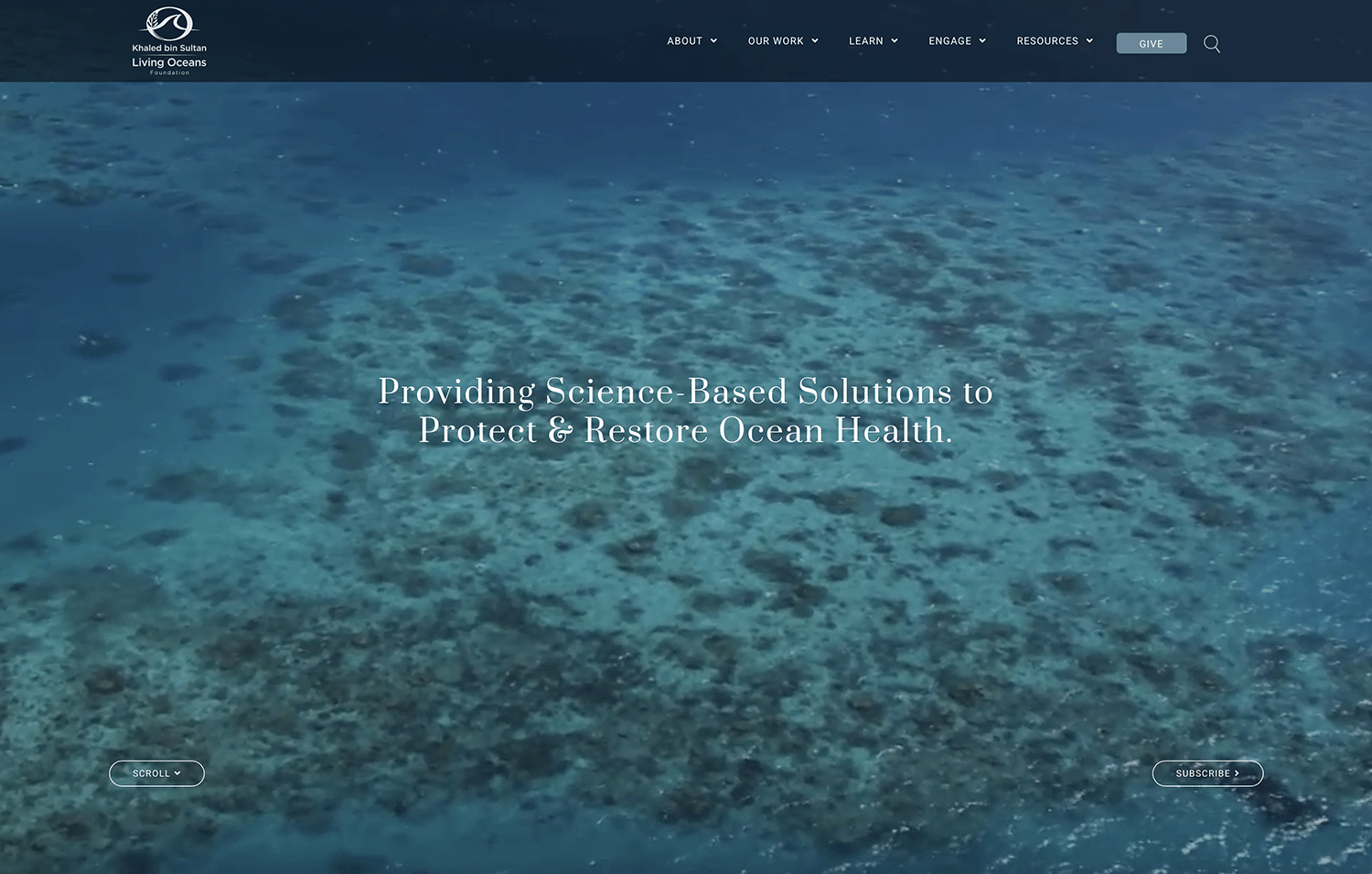Expedition Log: BIOT – Day 13
On a recent lagoonal dive in the center of Salomon Atoll I felt like I was at a carnival swimming through a pool of rainbow glazed popcorn. Fluorescent lime green, pink, purple, blue and snow-white corals carpeted the seafloor, each one more colorful than the last. The colorful corals were in stark contrast to the rest of the seafloor – dark green or brown seaweed covered rocks and the occasional brown, dark green or grey coral.
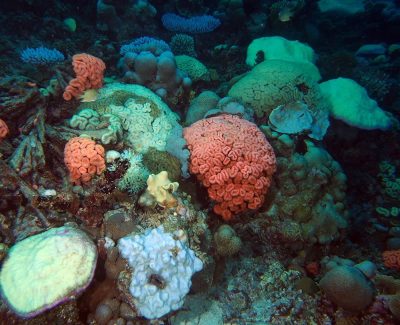
Vividly colored corals and unusually calm seas were indicative of something ‘not normal’ in BIOT
While beautiful, I knew this was not normal. Over the last four weeks we’ve experienced unusually calm doldrum-like conditions – the sea was like glass – and as warm as bathwater (well, 30-31° C). During most other research missions we were “treated” to extended periods of unusually strong currents, heavy wave action, much cooler temperatures (25-29° C), overcast skies and periodic squalls with heavy rain. While this makes for challenging diving, it is good for the corals, as they become stressed when the temperatures climb too high and ultraviolet radiation penetrates the surface. Under conditions like we were witnessing in BIOT, the corals have begun to undergo bleaching. Coral bleaching occurs when the coral animals expel the algal cells (zooxanthellae) which usually live in their tissues. These algae are pigmented from the chlorophyll they use for photosynthesis, giving the colony a dark green to brown color. When the algae are expelled, the coral tissue is mostly transparent, making the white limestone skeleton visible. Often, a coral produces fluorescent pigments, so a bleached coral may appear lime green, purple, pink, red or blue.
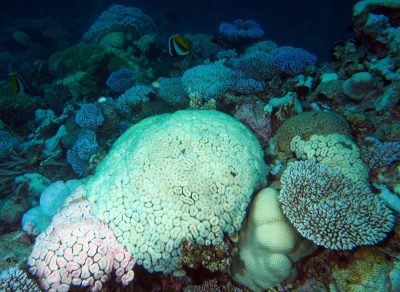
Bleached corals may appear lime green, purple, pink, red or blue.
During our first research mission to BIOT (March 10-31, 2015) bleaching was rare; only a few isolated pale colonies were noted. Beginning on April 15 we started to see a high number of table acroporids that were pale to yellow in color, and partial bleaching (mottled and pale colonies) on other corals. Over the next week bleaching increased substantially on table acroporids. Completely bleached colonies of Pocillopora, small digitate acroporids, Seriatopora and other smaller corals were also common in shallow water, and several genera, such as Stylophora, displayed bleached branch tips. By April 25, most of the table acroporids were white, light yellow or light blue, and numerous other corals, especially lobe coral (Lobophyllia), all of the mushroom corals, short, stout-branched corals (acroporids, Pocillopora, and Stylophora), and massive species such as Symphyllia and Goniopora were various fluorescent shades of blue, yellow or green. We also saw many species, such as Galaxea, numerous genera of faviids, hydrozoan corals (Millepora) and certain anemones that were stark white.
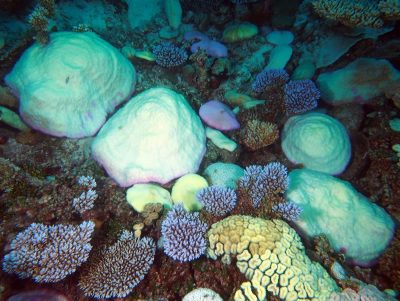
Acroporids, helmet corals, and lobe coral in the process of bleaching.
Bleaching has continued to increase in severity, with most corals in shallow (<10 m) fore reef locations now fully bleached (e.g. Isopora, Stylophora, Pocillopora, digitate and branching acroporids, faviids, Astreopora, Hydnophora, Pavona, and Physogyra). Shallow lagoonal reefs (2-10 m depth) are also showing severe signs of bleaching, and more than half the corals in deeper areas being pale, mottled or fully bleached, including many of the resistant massive frame building corals such as Porites as well as foliaceous and plating corals, with bleaching seen to 35 m depth.
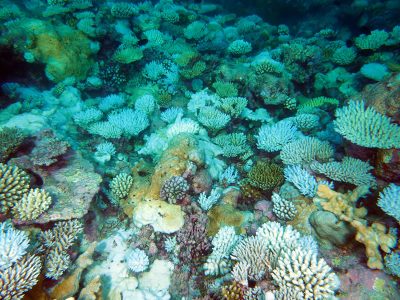
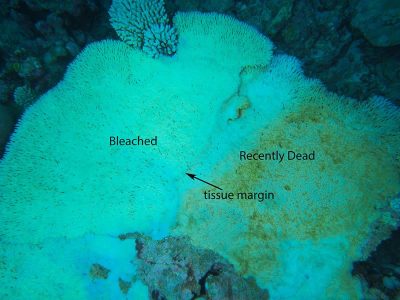
A bleached shallow reef in Salomon Atoll. / Bleaching mortality in Acropora cytherea.
(click-thru on images for greater detail)
The bleached table acroporids on the fore reef have also started to die, with colonies becoming a mosaic of rapidly expanding denuded patches of skeleton.

Bleached table acroporids, Acropora cytherea, and A tenuis.
What seems unusual is the spatial variability of bleaching. Some atolls and reef systems show high prevalence of bleaching, while others had many fewer bleached corals. Also, a high variability among taxa is noted, with bleached colonies occurring adjacent to a normal unbleached colony of the same species. For example, on many reefs you can find a completely white Porites lutea colony in between a blue colony of the same species on one side and a dark brown colony on the other. Acropora tenuis stands, which can cover tens of meters on some lagoonal reefs, are a mix of fully bleached colonies, colonies that are dark brown, and colonies with white branch tips.
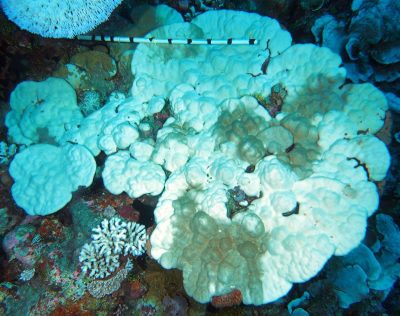

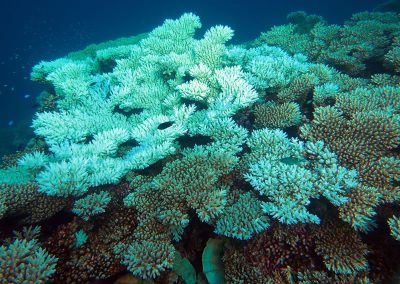
A large Porites lutea with mottled bleaching. (right) / A. tenuis bleached while its neighors remain unbleached. (middle) / The stark contrast between bleached and normal A. tenuis. (right)
(click-thru on images for greater detail)
The duration and ultimately the impact of this event is currently unknown. Nevertheless, there are numerous indicators that suggest these reefs are likely to bounce back, even if there is high mortality. There is evidence that BIOT sustained high mortality (up to 100%) following the 1998 El Niño, but the reefs quickly rebounded. A study carried out in 2006 suggested that shallow reefs were similar in structure and cover to that of 25 years earlier. We have also recorded unusually high levels of recruitment on most reefs. There are several sites that were damaged in the recent past by crown of thorns starfish, bleaching, white syndrome, and possibly other large-scale natural disturbances, but these were dominated by high numbers of recruits and populations of healthy, juvenile corals. The high cover of red crustose coralline algae, near absences of cyanobacteria and macroalgae, and high biomass of herbivores are also apparent on most reefs. Furthermore, previous studies have also reported very high levels of herbivory, low nutrient levels, and a near absence of pollutants, all of which suggest these systems can rebound quickly from a bleaching event.
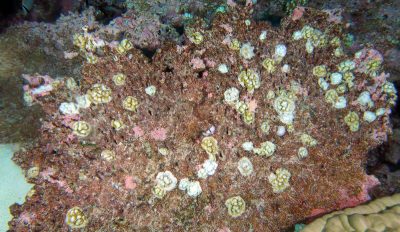
The high recruitment on this dead table acroporid is just one indicator suggesting these reefs are likely to bounce back.
Photos by Andrew Bruckner.

